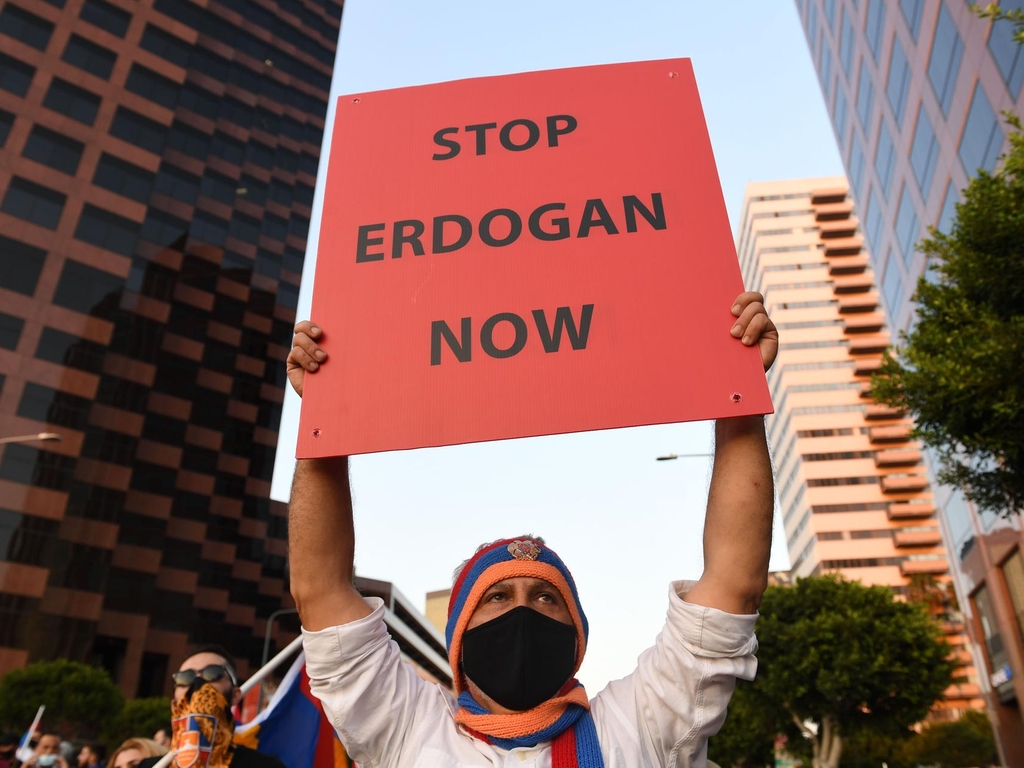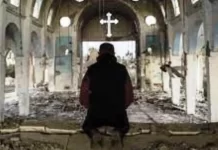The Battle of Lepanto: When Turks Skinned Christians Alive for Refusing Islam
Raymond Ibrahim/October 07/2020
ريموند إبراهيم: في معركة ليبانتو سلخ الأتراك جلود المسيحيين وهم أحياء لرفضهم الإسلام
Turkey Rekindles the Armenian Genocide
Raymond Ibrahim/FrontPage Magazine/October 07/2020
ريموند إبراهيم: تركيا تعيد إحياء الإبادة الجماعية للأرمن
******
Turkey Rekindles the Armenian Genocide
Raymond Ibrahim/FrontPage Magazine/October 07/2020
ريموند إبراهيم: تركيا تعيد إحياء الإبادة الجماعية للأرمن
As it has done in other arenas where “extremists” are attacking moderates or Christians—from Syria to Libya to Nigeria—Turkey is spearheading another jihad, this time against Christian Armenia.
Context: Fighting recently erupted in the region of Nagorno-Karabakh, which borders Armenia and Azerbaijan. Although it is ethnically Armenian, after the dissolution of the USSR, the territory was allotted to Muslim Azerbaijan. Since then, hostilities and skirmishes have erupted, though the current one, if not quenched—an Azerbaijani drone was shot down above the Armenian capital and Azerbaijan is threatening to bomb Armenia’s unsecure nuclear power plant—can have serious consequences, including internationally.
By doing what it does best—funding, sponsoring, and transporting terrorists to troubled regions—Turkey has exacerbated if not sparked tensions. Several reports and testimonials, including by an independent French journalist, have confirmed that Turkey is funneling jihadi groups that had been operating in Syria and Libya—including the pro-Muslim Brotherhood Hamza Division, which kept naked, sex slave women in prison—to this latest theater of conflict.
As French president Macron recently explained, “We now have information which indicates that Syrian fighters from jihadist groups have (transited) through Gaziantep (southeastern Turkey) to reach the Nagorno-Karabakh theatre of operations…. It is a very serious new fact, which changes the situation.”
The “quality” of these incoming “freedom fighters”—as the Western mainstream media, particularly during the Obama era, was wont to call them—is further evidenced by their attempts to enforce sharia, Islamic law, on some of their more secularized hosts in Azerbaijan.
After asking, “Why has Turkey returned to the South Caucasus 100 years [after the dissolution of the Ottoman Empire]?” Nikol Pashinyan, Armenia’s prime minister, answered in a statement: “To continue the Armenian Genocide.” This is a reference to the well documented massacre of an estimated 1.5 million Armenians, 750,000 Greeks and 300,000 Assyrians—a total of 2.5 million Christians—slaughtered at the hands of Turks and in the name of jihad.
While Pashinyan is correct in characterizing the latest hostilities as a reflection of Turkey’s attempt “to continue the Armenian Genocide” of the nineteenth-twentieth centuries, in fact, the continuum of Turkic attacks on Armenia stretch back more than a thousand years ago, when the Turks first cleansed the Armenians from their ancient homeland, also in accordance with jihadi ideology.
Then and now, Azerbaijanis participated. During one of the eleventh century jihads on Armenia, the great cross of an ancient church was torn down, mocked and desecrated, and then sent to adorn a mosque in Azerbaijan; more recently, after hostilities erupted, Azerbaijanis surrounded the Armenian embassy in Washington, D.C. this last summer, while chanting about jihad.
The Armenian prime minister continues:
For Turkey, however, continuing a genocidal policy is not only a means of implementing Armenophobia, but also a pragmatic task. Armenia and the Armenians of the South Caucasus are the last remaining obstacle on the way of continued Turkish expansion towards the North, the North East, and the East, and the realization of its imperialistic dream.
It is no longer merely the Karabakh issue, nor a security issue of the Armenian people. It is now an issue of international security, and today, the Armenian people are defending also international security, assuming what may be a new historic mission.
In other words, he is saying that only Christian Armenia (Georgia would be included too) stands between Turkey and some sort of unification with the many Muslim nations to its east (the “Stans,” e.g., Turkmenistan).
Certainly Turkey’s ambitions are not to be doubted. Whether by citing history’s most sadistic jihadis as paragons of virtue and emulation, or by transforming the Hagia Sophia into a mosque, or by helping to destabilize moderate Muslim governments and slaughter Christians with its jihadi militias, Turkey’s imperialistic dreams of resuccisitating the Ottoman Empire have been increasingly on display.
The editor-in-chief of Yeni Safak, a Turkish newspaper, recently called for as much in an article partially titled “Turkey is a global power. Now it’s time for Azerbaijan to rise.” After saying that Turkey had taken “a century-long hiatus” from its “geopolitical” ambitions and its “region-builder mind that founded very powerful empires on earth,” the Turkish daily claimed that “Our aim is not to spread conflicts but to replace, reinstate what rightfully belongs to us. Our aim is to keep alive and maintain our region, our people, our resources, our identity, and belonging.”
Despite all this and as it was during Obama’s role in the “Arab Spring,” the U.S. finds itself on the side of the jihad, even if unwittingly. “The international community, especially the American society,” Pashinyan warned, “should be aware that U.S.-made F-16s are being used to kill Armenians in this conflict.” Because both the U.S. and Turkey are NATO members, Turkey is acquiring and using against Armenians weapons from the U.S.
And so history continues to repeat itself—in all ways.
The Battle of Lepanto: When Turks Skinned Christians Alive for Refusing Islam
Raymond Ibrahim/October 07/2020
ريموند إبراهيم: في معركة ليبانتو سلخ الأتراك جلود المسيحيين وهم أحياء لرفضهم الإسلام
Drawing of the torture and subsequent flaying of Marco Bragadin, for rejecting the invitation to Islam.
Today in history, on October 7, 1571, one of the most cataclysmic clashes between Islam and the West — one where the latter for once crushed and humiliated the former — took place.
In 1570, Muslim Turks — in the guise of the Ottoman Empire — invaded the island of Cyprus, prompting Pope Pius V to call for and form a “Holy League” of maritime Catholic nation-states, spearheaded by the Spanish Empire, in 1571. Before they could reach and relieve Cyprus, its last stronghold at Famagusta was taken through treachery.
After promising the defenders safe passage if they surrendered, Ottoman commander Ali Pasha — known as Müezzinzade (“son of a muezzin”) due to his pious background — had reneged and launched a wholesale slaughter. He ordered the nose and ears of Marco Antonio Bragadin, the fort commander, hacked off. Ali then invited the mutilated infidel to Islam and life: “I am a Christian and thus I want to live and die,” Bragadin responded. “My body is yours. Torture it as you will.”
So he was tied to a chair, repeatedly hoisted up the mast of a galley, and dropped into the sea, to taunts: “Look if you can see your fleet, great Christian, if you can see succor coming to Famagusta!” The mutilated and half-drowned man was then carried near to St. Nicholas Church — by now a mosque — and tied to a column, where he was slowly flayed alive. The skin was afterward stuffed with straw, sown back into a macabre effigy of the dead commander, and paraded in mockery before the jeering Muslims.
News of this and other ongoing atrocities and desecrations of churches in Cyprus and Corfu enraged the Holy League as it sailed east. A bloodbath followed when the two opposing fleets — carrying a combined total of 600 ships and 140,000 men, more of both on the Ottoman side — finally met and clashed on October 7, 1571, off the western coast of Greece, near Lepanto.
According to one contemporary:
The greater fury of the battle lasted for four hours and was so bloody and horrendous that the sea and the fire seemed as one, many Turkish galleys burning down to the water, and the surface of the sea, red with blood, was covered with Moorish coats, turbans, quivers, arrows, bows, shields, oars, boxes, cases, and other spoils of war, and above all many human bodies, Christians as well as Turkish, some dead, some wounded, some torn apart, and some not yet resigned to their fate struggling in their death agony, their strength ebbing away with the blood flowing from their wounds in such quantity that the sea was entirely coloured by it, but despite all this misery our men were not moved to pity for the enemy. … Although they begged for mercy they received instead arquebus shots and pike thrusts.
The pivotal point came when the flagships of the opposing fleets, the Ottoman Sultana and the Christian Real, crashed into and were boarded by one another. Chaos ensued as men everywhere grappled; even the grand admirals were seen in the fray, Ali Pasha firing arrows and Don Juan swinging broadsword and battle-axe, one in each hand.
In the end, “there was an infinite number of dead” on the Real, whereas “an enormous quantity of large turbans, which seemed to be as numerous as the enemy had been, [were seen in the Sultana] rolling on the deck with the heads inside them.” The don emerged alive, but the pasha did not.
When the central Turkish fleets saw Ali’s head on a pike in the Sultana and a crucifix where the flag of Islam once fluttered, mass demoralization set in, and the waterborne mêlée was soon over. The Holy League lost twelve galleys and ten thousand men, but the Ottomans lost 230 galleys — 117 of which were captured by the Europeans — and thirty thousand men.
It was a victory of the first order, and Catholic, Orthodox, and Protestants rejoiced.
Ottoman commander Ali Pasha al-Müezzinzade engaging the Christian galleys
Practically speaking, however, little changed. Cyprus was not even liberated by the Holy League. “In wrestling Cyprus from you we have cut off an arm,” the Ottomans painfully reminded the Venetian ambassador a year later. “In defeating our fleet [at Lepanto] you have shaved our beard. An arm once cut off will not grow again, but a shorn beard grows back all the better for the razor.”
Even so, this victory proved that the relentless Turks, who in previous decades and centuries had conquered much of Eastern Europe, could be stopped. Lepanto suggested that the Turks could be defeated in a head-on clash — at least by sea, which of late had been the Islamic powers’ latest hunting grounds. As Miguel Cervantes, who was at the battle, has the colorful Don Quixote say: “That day … was so happy for Christendom, because all the world learned how mistaken it had been in believing that the Turks were invincible by sea.”
Modern historians affirm this position. According to military historian Paul K. Davis, “More than a military victory, Lepanto was a moral one. For decades, the Ottoman Turks had terrified Europe, and the victories of Suleiman the Magnificent caused Christian Europe serious concern. … Christians rejoiced at this setback for the Ottomans. The mystique of Ottoman power was tarnished significantly by this battle, and Christian Europe was heartened.”
No matter how spectacular, however, defeat at sea could not shake what was first and foremost a land power — so that more than a century later, in 1683, some 200,000 armed Ottomans had penetrated as far as and besieged Vienna.
But that — to say nothing of Turkey’s many other jihads down to the present — is another story.
Historical quotes in this article were excerpted from the author’s Sword and Scimitar: Fourteen Centuries of War between Islam and the West — a book that CAIR and its Islamist allies did everything they could to prevent the U.S. Army War College from learning about.




















